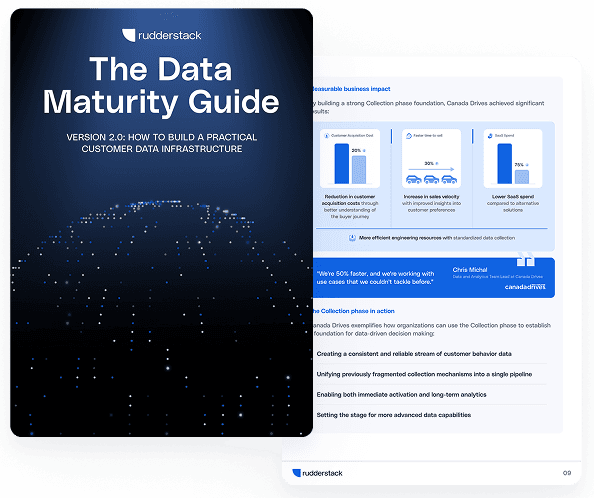How AI data integration transforms your data stack

Every data team dreams of seamless integration, data flowing effortlessly between tools, platforms, and teams.
But in reality, they're often stuck stitching together brittle pipelines, managing schema mismatches, and wrangling inconsistent formats across dozens of systems. AI data integration is changing this picture by automating the most tedious and error-prone parts of the process, from mapping schemas to identifying anomalies and adapting to changes in real time.
With the global artificial intelligence market surpassing $184 billion U.S. dollars in 2024, it's clear that AI is reshaping how data infrastructure is built and scaled. Instead of spending cycles writing and rewriting code to connect each system manually, your engineering team can focus on innovation and delivering value faster.
This article breaks down what AI data integration means, explores key benefits like faster time-to-insight and improved data quality, and walks through practical use cases and implementation strategies.
Main takeaways:
- AI data integration automates mapping, transformation, and schema detection, reducing manual engineering effort and accelerating time to deployment
- Machine learning models continuously learn from your data to improve field matching, normalization, and anomaly detection
- AI unifies fragmented data sources into a consistent format, enabling better analytics, real-time insights, and comprehensive customer views
- Built-in data quality checks and governance features ensure compliance, security, and trust across your data stack
- AI-powered pipelines adapt to schema changes and scale with your data, helping platform teams maintain resilient, efficient infrastructure
What is AI data integration?
AI data integration uses artificial intelligence to automate connecting, transforming, and delivering data across systems. It replaces manual coding with intelligent algorithms that learn how to map and process data from different sources.
Unlike traditional methods, AI data integration adapts to changing data structures automatically. It recognizes patterns, suggests mappings, and fixes errors without constant human intervention.
The technology combines machine learning with data pipeline tools to create a more efficient flow of information throughout your organization.
The shift from manual to intelligent workflows
Traditional data integration requires engineers to manually write code for each connection. This approach is time-consuming and error-prone.
AI-powered integration learns from your data and previous mappings. It can suggest field matches, detect schema changes, and adapt to new data formats automatically.
- Reduced manual effort: AI handles repetitive mapping tasks so engineers can focus on higher-value work.
- Faster implementation: New integrations can be deployed in days instead of weeks or months.
- Self-improving accuracy: Systems learn from corrections and become more precise over time.
Why manual integration falls short
Global data creation hit 149 zettabytes in 2024 and is on track to double by 2028—far beyond what manual processes can handle. Scalable, automated integration is now a necessity.
Why traditional data approaches struggle
Legacy ETL tools and hand-coded scripts weren't designed for today's complex data environments. They require constant maintenance as data sources evolve.
Traditional methods also struggle with scale. As data volumes grow, manual processes become bottlenecks. Human errors in mapping and transformation create data quality issues. These problems compound as data moves through your stack.
Inconsistent schemas and data silos
Most organizations have data trapped in disconnected systems with different formats. These data silos prevent a complete view of your business.
AI system integration helps overcome these challenges by automatically detecting and resolving schema differences. It creates a consistent data model across your entire stack.
- Standardized formats: AI converts dates, currencies, and identifiers into consistent formats.
- Entity resolution: Intelligent matching identifies the same customer or product across different systems.
- Automated normalization: Data is transformed to fit your warehouse schema without manual coding.
Key AI techniques for data integration
Several AI technologies work together to power modern data integration solutions.
Machine learning algorithms identify patterns in your data and learn how to map fields between systems. Natural language processing helps understand text data and extract meaningful information.
Pattern recognition detects anomalies and ensures data quality. These technologies combine to create intelligent pipelines that improve over time.
Machine learning for automated mapping
Machine learning models analyze your existing data to suggest field mappings between systems. They identify relationships that might not be obvious to human engineers.
For example, an ML model might recognize that customer_id in one system matches user_key in another based on the values and patterns in each field.
These models also learn from your corrections, becoming more accurate with each integration project.
See AI-powered data integration in action
Discover how RudderStack can help you build real-time, intelligent data pipelines for your organization. Request a demo
Deep learning for complex data patterns
Deep learning networks handle more complex integration challenges involving unstructured data. They can extract information from documents, images, and text.
This capability is especially valuable for AI system integrations with legacy systems that contain valuable but poorly structured data.
For example, deep learning can parse PDF invoices or extract customer sentiment from support tickets, making this data available for analysis.
How AI transforms your data stack: Key use cases
AI integration creates an intelligent layer that connects your data sources to destinations. It sits between your collection points and analytics tools.
This layer continuously monitors data flows, adapts to changes, and ensures quality. It makes your entire stack more resilient and responsive.
| Component | Traditional approach | AI-enhanced approach |
|---|---|---|
Data collection | Manual connectors | Automated discovery and ingestion |
Data processing | Static transformations | Adaptive, learning-based transforms |
Data storage | Batch updates | Real-time streaming |
Analytics | Manual reporting | Automated insights |
Real-time data ingestion and event streaming
AI data integration enables real-time processing of events as they happen. This capability is crucial for time-sensitive use cases.
Event streaming captures user actions, system changes, and business transactions the moment they occur. AI helps filter, route, and process these events intelligently.
Real-time capabilities allow you to react immediately to customer behavior, market changes, or operational issues.
Examples of real-time use cases include:
- Fraud detection in financial transactions
- Inventory updates in retail
- Personalized recommendations in digital products
- Equipment monitoring in manufacturing
Unifying large volumes of data
AI excels at handling diverse data types from multiple sources. It can process structured database records, unstructured text, and semi-structured formats like JSON.
Modern businesses collect data from websites, mobile apps, CRM systems, and IoT devices. AI data integration brings all this information together into a unified view, addressing a top infrastructure challenge since data management is the most difficult task for many organizations.
This unified approach enables better analytics, more accurate machine learning models, and comprehensive customer profiles.
Addressing data quality and governance
AI improves data quality by automatically detecting and correcting issues. It identifies duplicate records, inconsistent formats, and outliers.
For governance, AI helps enforce privacy rules and compliance requirements. It can detect sensitive data and apply appropriate protection measures.
These capabilities ensure your integrated data is trustworthy and secure.
Automated data quality checks
AI continuously monitors your data for quality issues. It learns what "good data" looks like for your business and flags exceptions.
- Pattern detection: Identifies unusual values or relationships that might indicate errors.
- Consistency validation: Ensures related data points match across systems.
- Completeness verification: Checks that required fields contain valid information.
These automated checks prevent bad data from contaminating your warehouse or analytics.
Ensuring compliance and security
Modern AI system integration solutions include built-in security and compliance features. They help protect sensitive information while enabling safe data sharing.
AI can automatically identify personally identifiable information (PII) and apply appropriate masking or encryption. It maintains detailed audit logs of all data access and transformations.
These capabilities make it easier to comply with regulations like GDPR, CCPA, and industry-specific requirements.
Key benefit: AI-powered governance lets you maintain control of your data while still making it accessible to those who need it.
Three steps to implement AI data integration
You don't need to overhaul your entire stack at once. Start with targeted use cases and expand as you see results.
1. Identify high-impact use cases
Begin with integration challenges that deliver immediate value. According to a 2024 report, the average organization has 10 AI projects in the pilot phase, 16 in limited deployment, but only 6 deployed at scale, highlighting how crucial it is to pick projects that can quickly reach production.
Good starting points include:
- Consolidating customer data from multiple sources
- Connecting operational systems to your data warehouse
- Automating reporting that currently requires manual data preparation
Focus on use cases that align with key business objectives.
2. Select the right infrastructure
Choose tools that fit your technical environment and team capabilities. Look for solutions that:
- Integrate with your existing data stack
- Provide the right balance of automation and control
- Include strong security and governance features
- Support real-time and batch processing
Cloud-native infrastructure offers the best combination of scalability and ease of implementation.
3. Operationalize and monitor AI pipelines
Once deployed, monitor your integration pipelines to ensure they perform as expected. Track key metrics like:
- Processing time: How quickly data moves through your pipeline
- Error rates: Percentage of records that fail processing
- Data freshness: How current your integrated data is
Use these metrics to identify areas for improvement and measure the impact of your AI integration efforts.
How to measure AI data integration ROI
To justify investment in AI data integration, track both technical metrics and business outcomes. Measure engineering time saved on pipeline development, data processing speeds, and reduced error rates alongside revenue impacts, customer retention improvements, and accelerated time-to-market for data-driven products.
Effective ROI measurement requires balancing quantitative efficiency gains with qualitative improvements in decision-making confidence and cross-functional data accessibility.
Tracking efficiency gains
Measure improvements in your data operations, including:
- Reduction in time to implement new integrations: Track how AI cuts development cycles from weeks to days by automating schema mapping and transformation logic
- Decrease in maintenance hours for existing pipelines: Quantify engineering time saved when AI automatically adapts to schema changes without manual reconfiguration
- Faster time-to-insight for business users: Measure the reduction in lag between data collection and availability in analytics dashboards
- Pipeline reliability improvements: Track the decrease in failed jobs and data delivery interruptions
- Resource utilization optimization: Monitor how AI right-sizes compute resources based on actual workload patterns
These efficiency gains translate directly to cost savings and competitive advantage. In fact, the implementation of data-driven strategies delivered 20-30% efficiency gains for a global fashion retailer, underscoring the tangible impact of well-orchestrated data integration.
Monitoring data accuracy improvements
Track improvements in data quality and accessibility:
- Reduction in data errors and inconsistencies: Measure decreases in duplicate records, mismatched fields, and format irregularities that previously required manual correction
- Increased data usage across teams: Quantify adoption rates of integrated datasets by marketing, product, and finance teams through dashboard access metrics
- Faster, more confident decision-making: Track reduced time between data availability and business actions, with fewer requests for data verification
- Improved entity resolution: Measure how accurately customer profiles are matched across systems, reducing fragmented views
- Enhanced data completeness: Monitor the percentage of required fields successfully populated across integrated systems
Future trends in AI-driven integrations
As teams realize near-term ROI from AI integration, several forward-looking trends are beginning to reshape what's next.
- Self-healing pipelines are projected to become more common, using anomaly detection to identify failures and apply remediation strategies based on historical patterns, reducing the need for manual troubleshooting. Edge computing is also expected to grow, enabling data processing closer to its source for faster filtering and aggregation before data reaches centralized systems.
- Continuous learning models capable of recognizing new formats, handling schema drift, and adjusting mappings autonomously are likely to become more prevalent. Federated learning approaches may also gain momentum, offering a way to improve model performance across distributed systems while maintaining data privacy.
If these trends continue as expected, AI-driven integration could become faster, more resilient, and more autonomous, helping teams manage complex data environments with significantly less effort.
Build intelligent, real-time pipelines with RudderStack
AI data integration is more than a technical upgrade—it's a strategic shift in how your organization manages and activates data. By automating schema mapping, anomaly detection, and transformation logic, AI enables faster, more reliable data pipelines that scale with your business. It reduces manual overhead, improves data quality, and accelerates your path to insights—all while strengthening governance and compliance.
RudderStack empowers your team to harness these AI capabilities within a secure, cloud-native customer data infrastructure. Our platform supports intelligent, real-time data pipelines that integrate seamlessly with your existing stack. Whether you're looking to automate ingestion, enrich customer profiles, or activate data across tools, RudderStack provides the flexibility and control that modern data teams require.
We help you build intelligent, real-time data flows without compromising on privacy or governance. Ready to see how? Request a demo.
Published:
July 11, 2025








